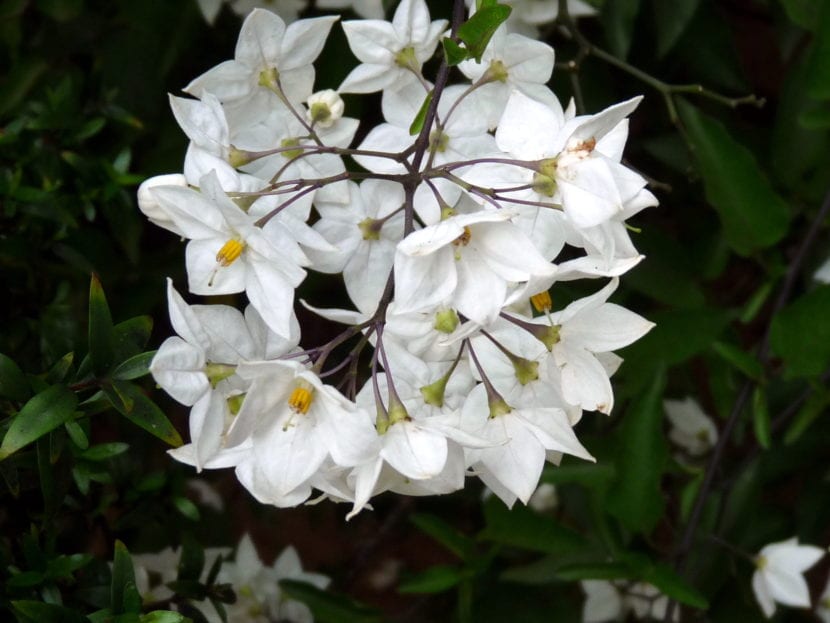
El fake jasmine It is one of the most interesting climbing plants to have in temperate climates: its easy cultivation and reproduction, in addition to its beautiful and elegant flowers, make it an ideal candidate to cover pergolas or lattices, and even to have in pots, since it tolerates very well pruned.
This interesting plant does not require any special maintenance, although like all, it also has its preferences, which are the ones that I am going to tell you next.
Main characteristics of false jasmine
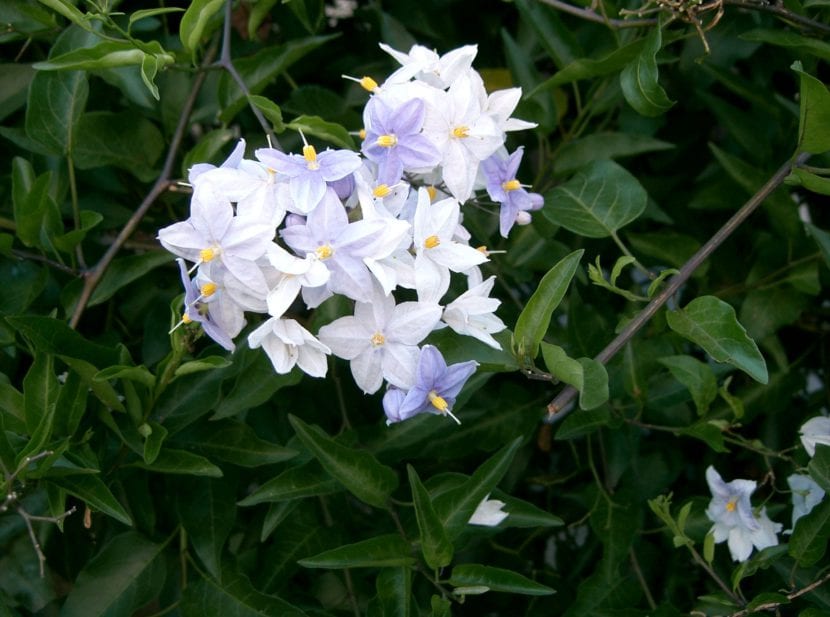
Our protagonist is known by the scientific name Solanum laxum, or also by one of its synonyms: Solanum jasminoides. It is a normally evergreen climbing shrub, but it can drop if it's cool or cold, and it can run out of them during winter. It belongs to the botanical family Solanaceae, and its stems grow in a very messy way, up to 5m long. This messy shape makes it highly appreciated in many gardens, as it gives it that sometimes rebellious character that can be found in nature.
The leaves are dark green, simple, up to 8cm long by 3cm wide. Its flowers, which sprout in spring, appear distributed in terminal corymbiform groups, lilac, bluish or whitish, with a diameter of up to 2cm. The fruit has a globose shape, and measures up to 1cm in diameter, purple-blackish in color, inside which are the seeds.
Solanum jasminoides care
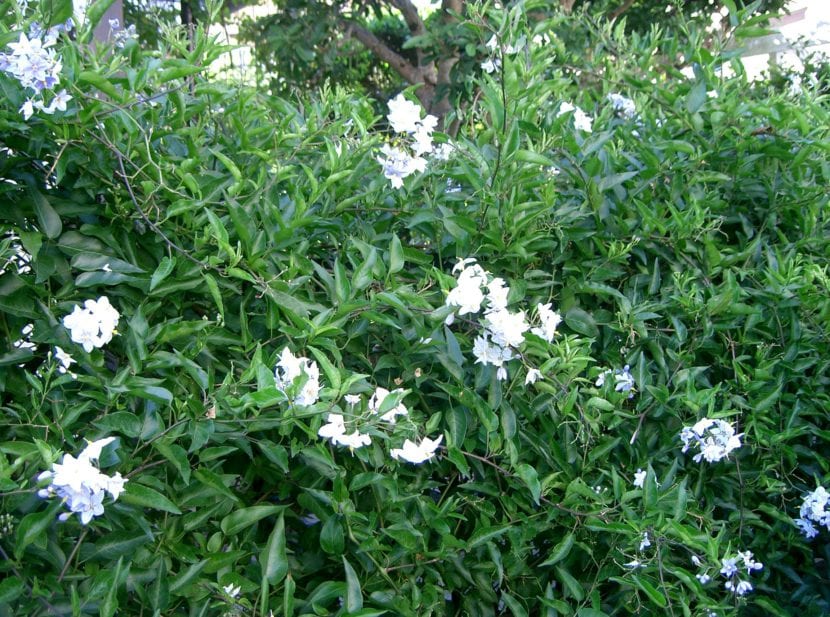
For your plant to grow healthy and strong, a number of things need to be taken into account. They are as follows:
Location
This is a plant that resists up to -4ºC, so if you can, An area where it is exposed to direct sunlight should be placed outside, although it can adapt to grow in semi-shade. In the case that you live in a cold area, in autumn it is convenient to protect it from frost either inside the home, wrapping it with greenhouse plastic or with a thermal gardening blanket.
Irrigation
Irrigation has to be frequent, especially in summer. The ideal is to water avoiding the substrate or soil from drying out too much. To do this, you must check the humidity of the same by inserting a thin wooden stick and observe how much soil adheres to it when it has been extracted: if it comes out practically clean, it will mean that the ground is dry and that, therefore, it can be watered .
Depending on the weather and the season, it will be necessary to water more, or less, but generally the frequency of irrigation will be 3 times a week in summer, and every 4-5 days the rest of the year.
Subscriber
The subscriber is optional. The false jasmine is a very resistant plant, but if you want, it can be fertilized with any universal fertilizer, or with organic fertilizers, for example adding a handful of worm humus or horse manure every 2-3 months.
Pruning
Towards the end of winter, it is recommended to prune it to "tidy" it up a bit, and incidentally, to make its flowers even more beautiful. The following branches must be removed:
- Those that look weak, dry or broken.
- Those that intersect.
- The shoots emerging from the base of the main stem.
Transplant
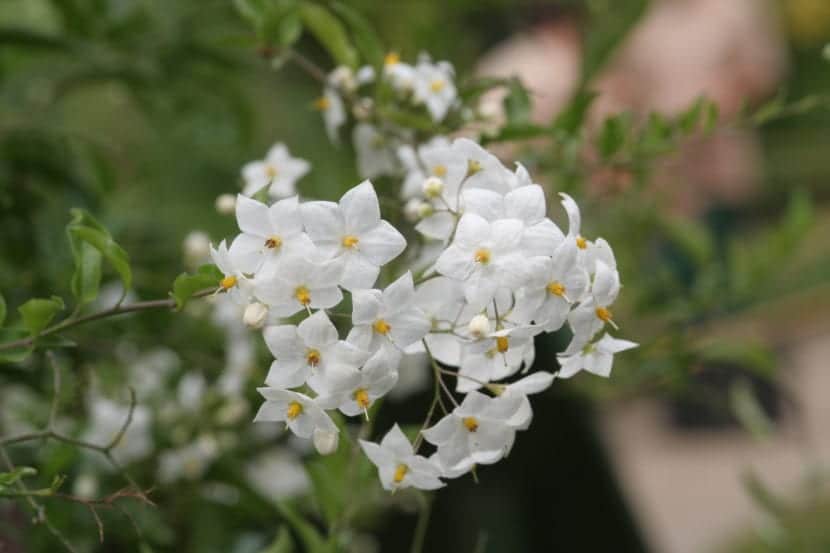
Whether you want to move to a larger pot, or directly to the garden floor, you have to do the homework in spring, after the risk of frost has passed. Let's see how to proceed in each case:
Potted
To transfer the fake jasmine to a larger pot, follow these steps:
- Take a flowerpot Make it at least 4cm wider and deeper than the previous one.
- Fill it with a little substrate, which can be a universal cultivation substrate mixed with perlite, or a mixture with 60% black peat + 30% perlite + 10% organic powder fertilizer (worm humus, horse manure, compost ... whatever you prefer).
- Extract the plant from its »old» pot. If you can't, tap it on different sides a few times; this way it will be easier. In the event that you have some roots sticking out of the drainage holes, ideally you should try to untangle them, but if they break, it will not pose a serious problem to the plant.
- Put it in its new pot. If you see that it is very low or very high, add or remove substrate as the case may be.
- Finish filling the pot with more substrate.
- Give it a good irrigation.
- Put a bamboo pole or similar so I can climb.
- Place it in an area where it is in direct sunlight, or is in semi-shade.
In the garden
To pass it to the garden, you just have to do the following:
- Make a planting hole, deep enough that it can fit well.
- Extract the plant from the pot.
- Enter it in the hole.
- Fill the hole with substrate universal culture mixed with 30% perlite.
- Get him a tutor That serves as a guide to the place you want it to cover, be it a lattice, a pergola, etc.
- Make a tree grate with the garden soil, so that it is about 3-4cm high. This way the water will not come out every time you water it.
- Water it, so that the earth is well soaked.
Pests and diseases of false jasmine
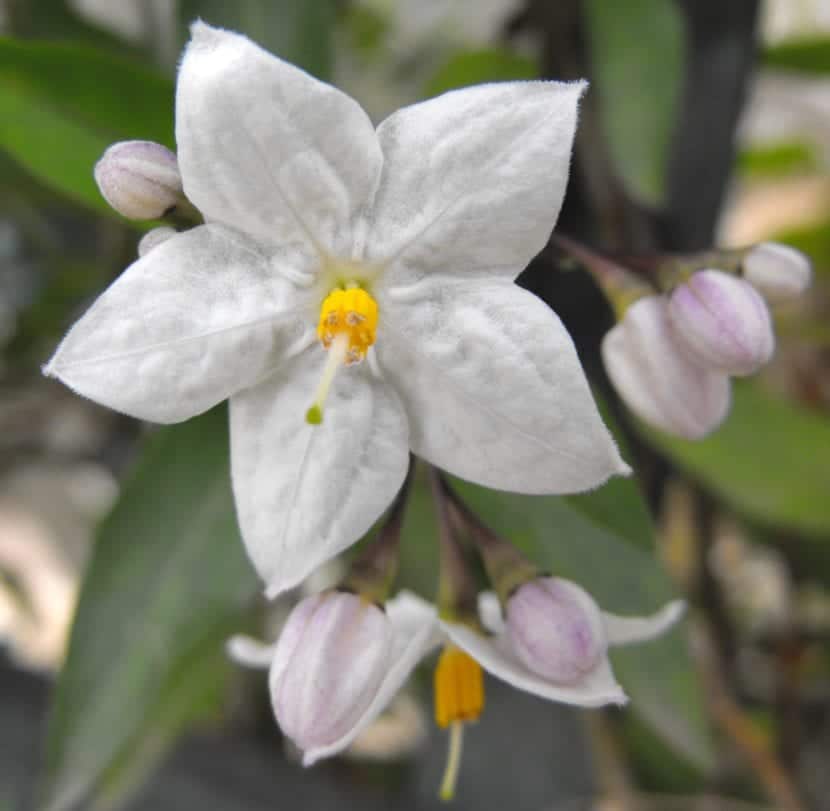
This is a plant that is not normally affected by pests or diseases. However, in very dry and hot environments it could have mealybugs, which can be removed with a swab from the ears soaked in soap and water.
Reproduction
Do you want to have new specimens of Solanum jasminoides? You can reproduce it by seeds, cuttings and air layering in spring. We tell you how:
By seeds
The seeds can be sown directly in a pot with a porous substrate, for example by mixing equal parts black peat with perlite. Place them on the surface, and cover them with a thin layer of soil. They will germinate in 2-4 weeks, keeping the substrate always slightly damp.
By cuttings
- Cut a branch at least 40cm long.
- Take off all the leaves except 2 (those that are higher).
- Put it in a pot with universal growing substrate.
- Place it in an area protected from the sun direct.
- Water.
In a period of 20-30 days it will begin to emit roots, as long as the substrate is kept slightly damp.
By air layering
- Select a branch that she is completely healthy.
- Make a bark ring, about 30cm from the tip of the branch. Gently remove the crust with a knife.
- Infuse this area with rooting hormones powdered.
- Take a plastic, either black or, more recommended, transparent, and surround the branch with it, tying it with a rope at the bottom.
- Fill it with black peat, and tie the other end with another piece of string.
- Now with a syringe introduce water to irrigate the substrate. Repeat every 10-15 days.
After 2-3 months you can carefully cut the layer so that the root ball does not crumble.

Fake jasmine is a very interesting plant, don't you think? What do you think?
Good morning:
I have three multi-year-old fake jasmine in my garden very close to two photinias on the tree. Since last year the false jasmines have been climbing around the photinia branches, mixing their foliage with that of the trees. I don't know if this can be bad for photinias and I should prune those branches from the fake jasmine or if I can let them intermingle and grow freely.
Thank you,
Urko
Good,
I wanted to know if this jasmine would hold up on a terrace with winds. It would be in a warm area of Malaga but relatively close to the sea
Hello Ezequiel.
In principle, I would put up with it. But would it be directly in front of the sea, or rather protected? If it is the former, it may be that it suffered some damage.
From experience (well, my sister's) true jasmine, that is, it is JasminumYes, it can withstand the sea wind.
Regards!